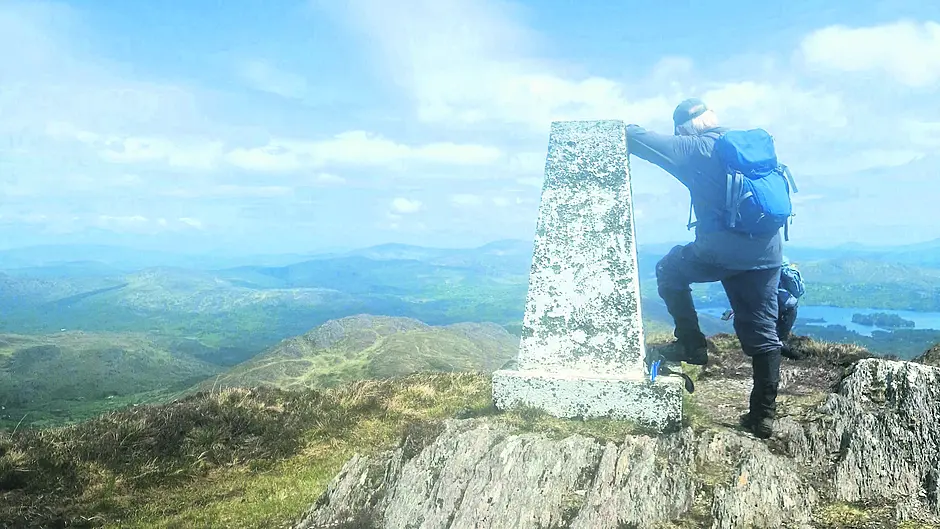This region of the country is blessed with wonderful walking routes. You don’t need anything but a good pair of walking shoes, and the benefits are many-fold, writes Mary McCarthy
WEST Cork is a walking paradise. And, as if to confirm its credentials in this area, the pilgrim path from Drimoleague to Gougane Barra was recently added as a credit route for starting the famous Camino de Santiago.
A 70-something-year-old Skibbereen native, retired quantity surveyor Desmond Barry recalled that when West Cork was in lockdown, there was nothing else to do except for walking.
Desmond is a member of the Skibbereen Walking Group, a club that is affiliated with Mountaineering Ireland and has approximately 95 members.
Around 60% of the club are women, whereas 20 years ago this would have been only 10%.
‘The reason for this change is women tend to be more health-conscious,’ said Desmond. ‘On any club walk, it has on average 25 people. They usually frequent quiet country roads and off-road fields once a fortnight, and there is hillwalking every two weeks.’
The nearest walking clubs are Dunmanway, Clonakilty and Bandon. A lot of members from these clubs are members of other clubs in the area. ‘The interest in walking in West Cork seems to have returned to pre-pandemic levels,’ he said. Desmond admits he joined to make friendships. He considers exercise to be important and so is the scenery and he likes learning about history, place, and local knowledge from the talks on the route.
‘The beauty looking out over Bantry Bay to see the sun shining on the water is what I enjoy,’ he said.
His favourite walk is on the hills in West Cork, because road walking is hard on the feet, and climbing is muscle-building. The Sheep’s Head, the Beara peninsula and the Mizen are the best locations for good walks and Desmond says he loves feeling elated at the finish and having a sense of achievement.
Sarah O’Brien, the HSE’s national lead for the healthy eating and active living programme, agreed there was an increase in walking during lockdown. But since people have returned to work, she believes it has slipped back, nationally.
Some have indeed maintained it, but it’s still not yet at the levels seen during Covid.
‘During the pandemic, people learned about the benefits of walking, because it was available in the 5km distance allowed. It provided social connections, was easy to do and the activity gave positive experiences,’ said Sarah.
‘In terms of physical health,’ she added, ‘it improves fitness, even with a moderate level of intensity. It supports breathing, reduces blood pressure, and helps maintain a healthier weight.
‘Regarding mental health,’ explained Sarah, ‘walking has a hugely positive impact on one’s well-being, because endorphins are released when you are active. It is best to walk in the fresh air and natural sunlight, and it’s proven to reduce the risk of depression and anxiety.’
Health benefits come from walking at a pace that is moderate for you, when the heart rate increases, breathing is heavier, and a conversation can be carried on, she said. ‘However, any activity is better than no activity!’
At present, we have brighter evenings, but as we move into the autumn, she cautioned, high vis jackets should be worn to be safe and seen. And a pair of comfortable shoes is important. Her recommendation was to, ideally, encourage people to build a habit of regular activity from a young age, so get those children out walking too!
ADD A SPOT OF BIRDWATCHING TO YOUR STROLL
DURING the pandemic, immersion in walking in nature was a stress reliever, which prompted a renewed interest in birdwatching.
It has a calming effect that is good for mental health, according to Niall Hatch of Bird Watch Ireland.
There was huge interest in the organisation’s website during the lockdowns, when the 2km and 5km restrictions were imposed. This measure was detected by an increase in traffic to the website by 500%.
People wanted to learn about garden birds, as they were spending more time in their local area. During the lockdowns, he remembers, there was a huge drop in traffic and background noise, the public enjoyed the songbirds and the dawn chorus, from March to May in particular.
‘Birdwatching is popular across all ages and all walks of life in the wetlands, headlands, and beaches,’ he said.
‘Summer migration brings the sand martin, wheatear swallows, willow warbler, blackcaps, and seabirds. The advantage to birdwatching is meeting like-minded people in a group activity with other members at all times of year, seeing the magnificence of the coastal areas or the garden and how it changes. Birds and nature give solace in the company of others you know.’









